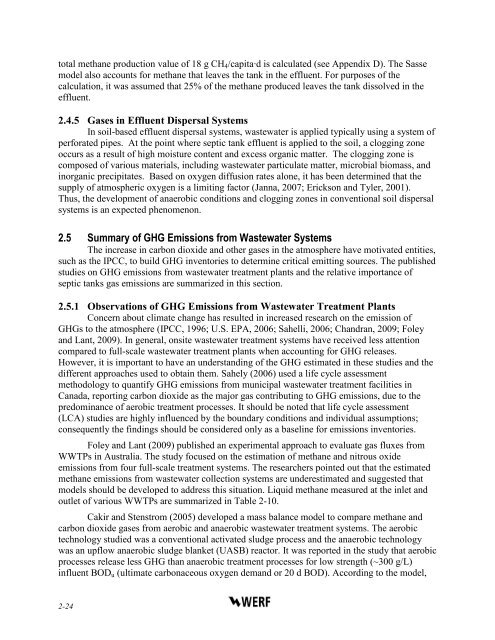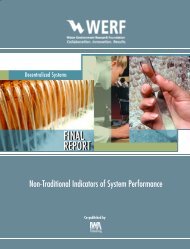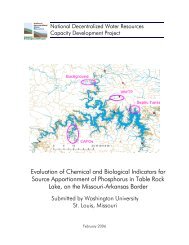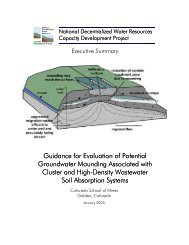Evaluation of Greenhouse Gas Emissions from Septic ... - Geoflow
Evaluation of Greenhouse Gas Emissions from Septic ... - Geoflow
Evaluation of Greenhouse Gas Emissions from Septic ... - Geoflow
Create successful ePaper yourself
Turn your PDF publications into a flip-book with our unique Google optimized e-Paper software.
total methane production value <strong>of</strong> 18 g CH 4 /capita·d is calculated (see Appendix D). The Sassemodel also accounts for methane that leaves the tank in the effluent. For purposes <strong>of</strong> thecalculation, it was assumed that 25% <strong>of</strong> the methane produced leaves the tank dissolved in theeffluent.2.4.5 <strong>Gas</strong>es in Effluent Dispersal SystemsIn soil-based effluent dispersal systems, wastewater is applied typically using a system <strong>of</strong>perforated pipes. At the point where septic tank effluent is applied to the soil, a clogging zoneoccurs as a result <strong>of</strong> high moisture content and excess organic matter. The clogging zone iscomposed <strong>of</strong> various materials, including wastewater particulate matter, microbial biomass, andinorganic precipitates. Based on oxygen diffusion rates alone, it has been determined that thesupply <strong>of</strong> atmospheric oxygen is a limiting factor (Janna, 2007; Erickson and Tyler, 2001).Thus, the development <strong>of</strong> anaerobic conditions and clogging zones in conventional soil dispersalsystems is an expected phenomenon.2.5 Summary <strong>of</strong> GHG <strong>Emissions</strong> <strong>from</strong> Wastewater SystemsThe increase in carbon dioxide and other gases in the atmosphere have motivated entities,such as the IPCC, to build GHG inventories to determine critical emitting sources. The publishedstudies on GHG emissions <strong>from</strong> wastewater treatment plants and the relative importance <strong>of</strong>septic tanks gas emissions are summarized in this section.2.5.1 Observations <strong>of</strong> GHG <strong>Emissions</strong> <strong>from</strong> Wastewater Treatment PlantsConcern about climate change has resulted in increased research on the emission <strong>of</strong>GHGs to the atmosphere (IPCC, 1996; U.S. EPA, 2006; Sahelli, 2006; Chandran, 2009; Foleyand Lant, 2009). In general, onsite wastewater treatment systems have received less attentioncompared to full-scale wastewater treatment plants when accounting for GHG releases.However, it is important to have an understanding <strong>of</strong> the GHG estimated in these studies and thedifferent approaches used to obtain them. Sahely (2006) used a life cycle assessmentmethodology to quantify GHG emissions <strong>from</strong> municipal wastewater treatment facilities inCanada, reporting carbon dioxide as the major gas contributing to GHG emissions, due to thepredominance <strong>of</strong> aerobic treatment processes. It should be noted that life cycle assessment(LCA) studies are highly influenced by the boundary conditions and individual assumptions;consequently the findings should be considered only as a baseline for emissions inventories.Foley and Lant (2009) published an experimental approach to evaluate gas fluxes <strong>from</strong>WWTPs in Australia. The study focused on the estimation <strong>of</strong> methane and nitrous oxideemissions <strong>from</strong> four full-scale treatment systems. The researchers pointed out that the estimatedmethane emissions <strong>from</strong> wastewater collection systems are underestimated and suggested thatmodels should be developed to address this situation. Liquid methane measured at the inlet andoutlet <strong>of</strong> various WWTPs are summarized in Table 2-10.Cakir and Stenstrom (2005) developed a mass balance model to compare methane andcarbon dioxide gases <strong>from</strong> aerobic and anaerobic wastewater treatment systems. The aerobictechnology studied was a conventional activated sludge process and the anaerobic technologywas an upflow anaerobic sludge blanket (UASB) reactor. It was reported in the study that aerobicprocesses release less GHG than anaerobic treatment processes for low strength (~300 g/L)influent BOD u (ultimate carbonaceous oxygen demand or 20 d BOD). According to the model,2-24











